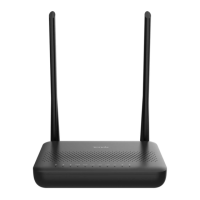It specifies the interface that the access control rule applies to, including LAN and WAN.
⚫
LAN: The ONT checks traffic from the LAN side according to the rule and decides to pass
it or discard it.
⚫
WAN: The ONT checks traffic from the WAN side according to the rule and decides to
pass it or discard it.
It specifies the protocol adopted by the traffic, or the types of traffic.
⚫
Any: It indicates that all types of traffic are under the control of this rule.
⚫
TELNET: Telnet is a protocol that provides a command line interface for communication
with a remote device or server, sometimes employed for remote management but also
for initial device setup like network hardware.
⚫
FTP: File Transfer Protocol (FTP) is a standard network protocol used for the transfer of
computer files between a client and server on a computer network.
⚫
TFTP: Trivial File Transfer Protocol (TFTP) is a simple file transfer protocol that allows a
client to get a file from or put a file onto a remote host.
⚫
HTTP: Hypertext Transfer Protocol (HTTP) is an application protocol and the foundation
of data communication for the World Wide Web, where hypertext documents include
hyperlinks to other resources that the user can easily access.
⚫
HTTPS: Hypertext Transfer Protocol Secure (HTTPS) is an extension of HTTP. SNMP is
used for secure communication over a computer network, and is widely used on the
Internet.
⚫
SNMP: Simple Network Management Protocol (SNMP) is the most widely used network
management protocol in TCP/IP networks, which enables you to remotely manage all
your network devices compliant with this protocol.
⚫
PING: Ping is a computer network administration software utility used to test the
reachability of a host on an IP network.

